Abstract
A stable live avirulent, genetically modified delta cya delta crp Salmonella typhimurium vaccine strain, chi 3985, was used in several vaccination strategies to evaluate its use in the control of Salmonella infection in chickens. Oral vaccination of chickens at 1 and at 14 days of age with 10(8) CFU of chi 3985 protected against invasion of spleen, ovary, and bursa of Fabricius and colonization of the ileum and cecum in chickens challenged with 10(6) CFU of virulent homologous Salmonella strains from group B. Chickens challenged with heterologous Salmonella strains from groups C, D, and E were protected against visceral invasion of spleen and ovary, while invasion of the bursa of Fabricius and colonization of ileum and cecum was reduced in vaccinated chickens. Oral vaccination at 2 and at 4 weeks of age induced an excellent protection against challenge with virulent group B Salmonella serotypes and very good protection against challenge with group D or E Salmonella serotypes, while protection against challenge with group C Salmonella serotypes was marginal but significant. Vaccination at 2 and at 4 weeks of age also protected vaccinated chickens against challenge with 10(8) CFU of highly invasive S. typhimurium or S. enteritidis strains. The protection of chickens vaccinated with chi 3985 against challenge with homologous and heterologous Salmonella serotypes is outstanding, and the complete protection against ovarian invasion in chickens challenged with 10(8) CFU of highly invasive S. typhimurium or S. enteritidis strains suggests that vaccination of chickens with chi 3985 can complement the present hygiene- and sanitation-based Salmonella control measures. This paper reports a breakthrough in the use of live avirulent vaccine to control Salmonella carriers in chickens.
Full text
PDF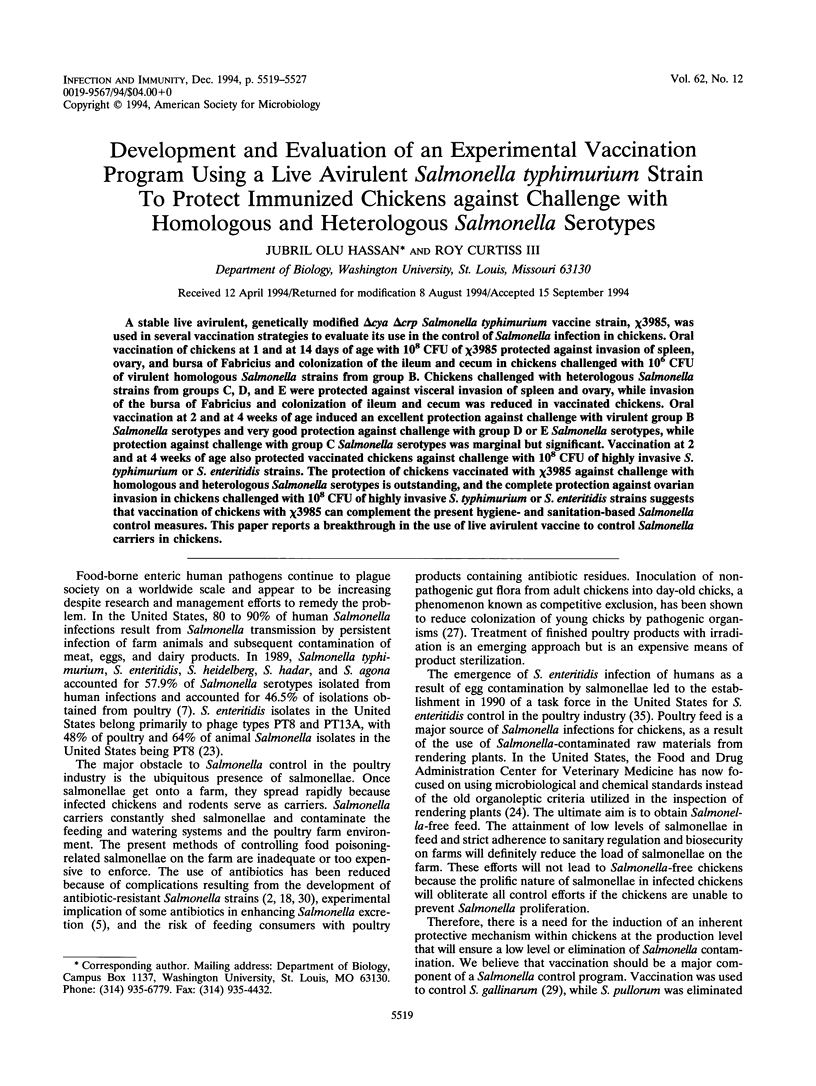
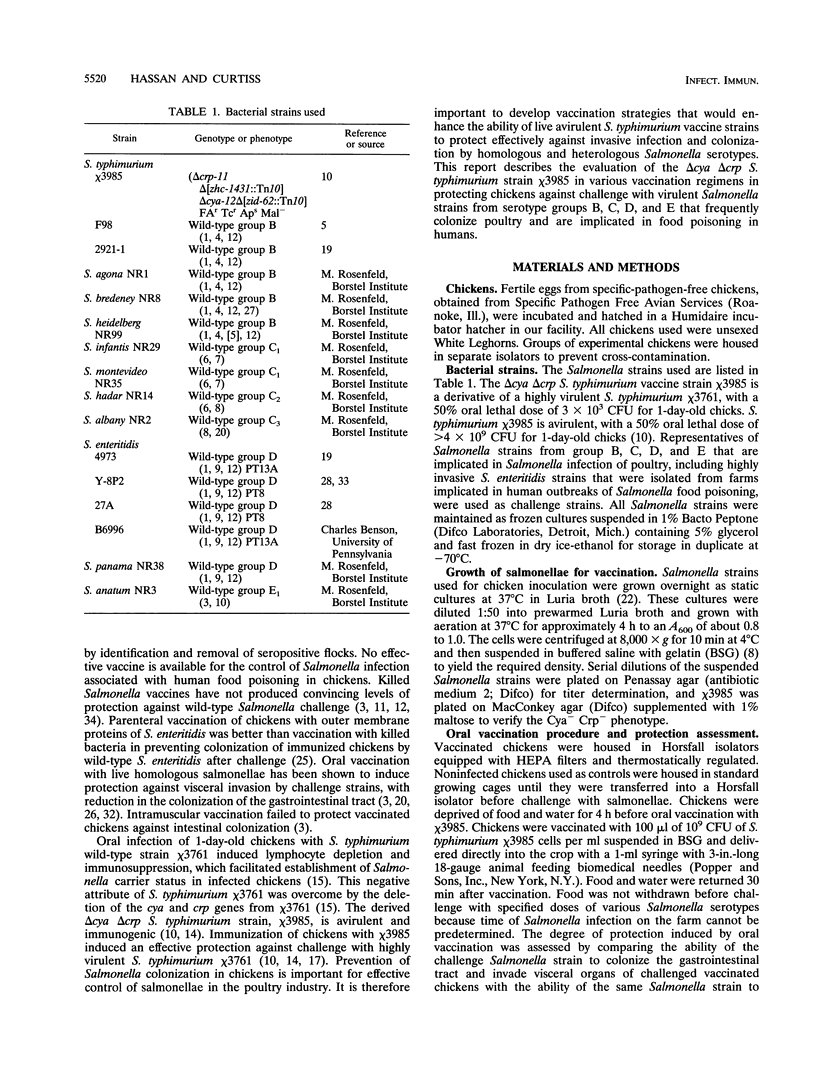
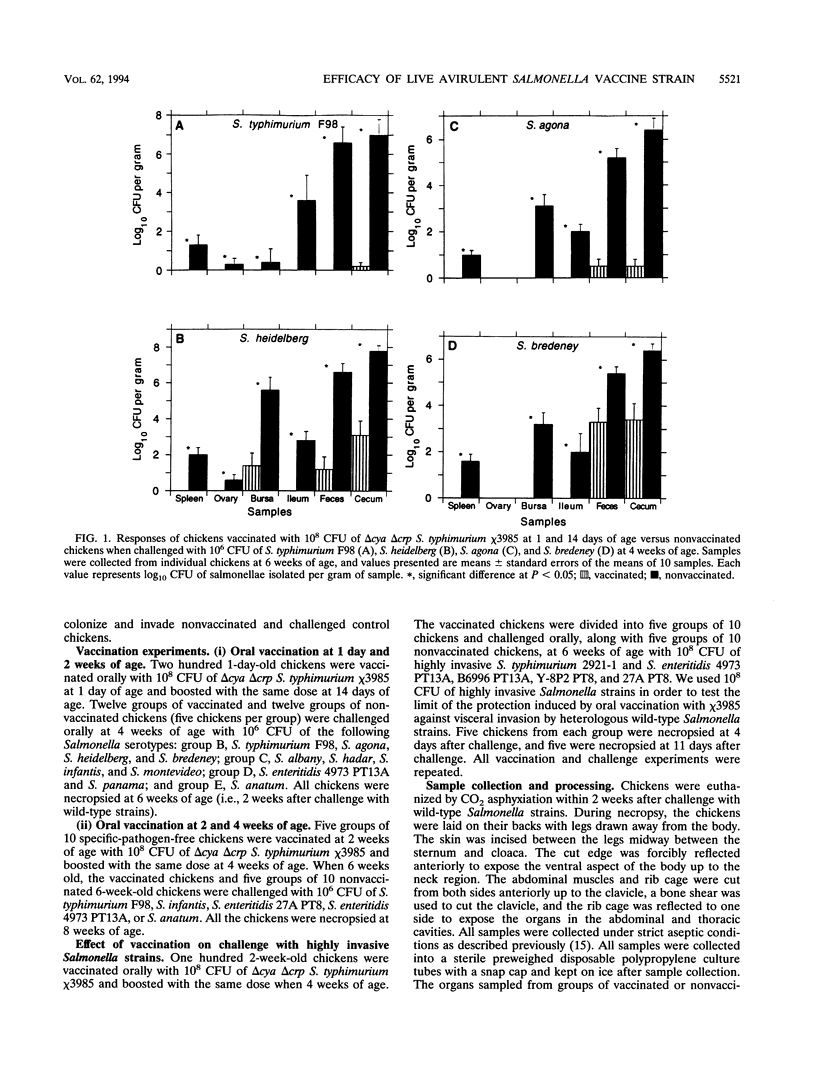
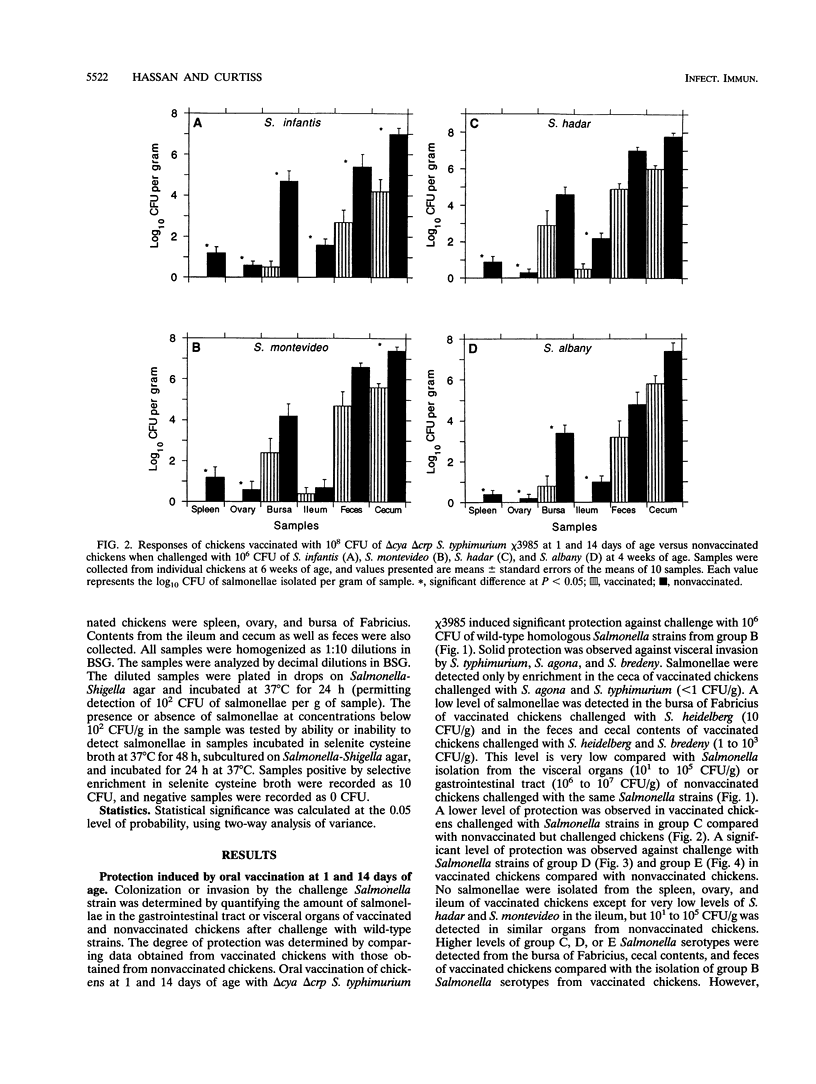
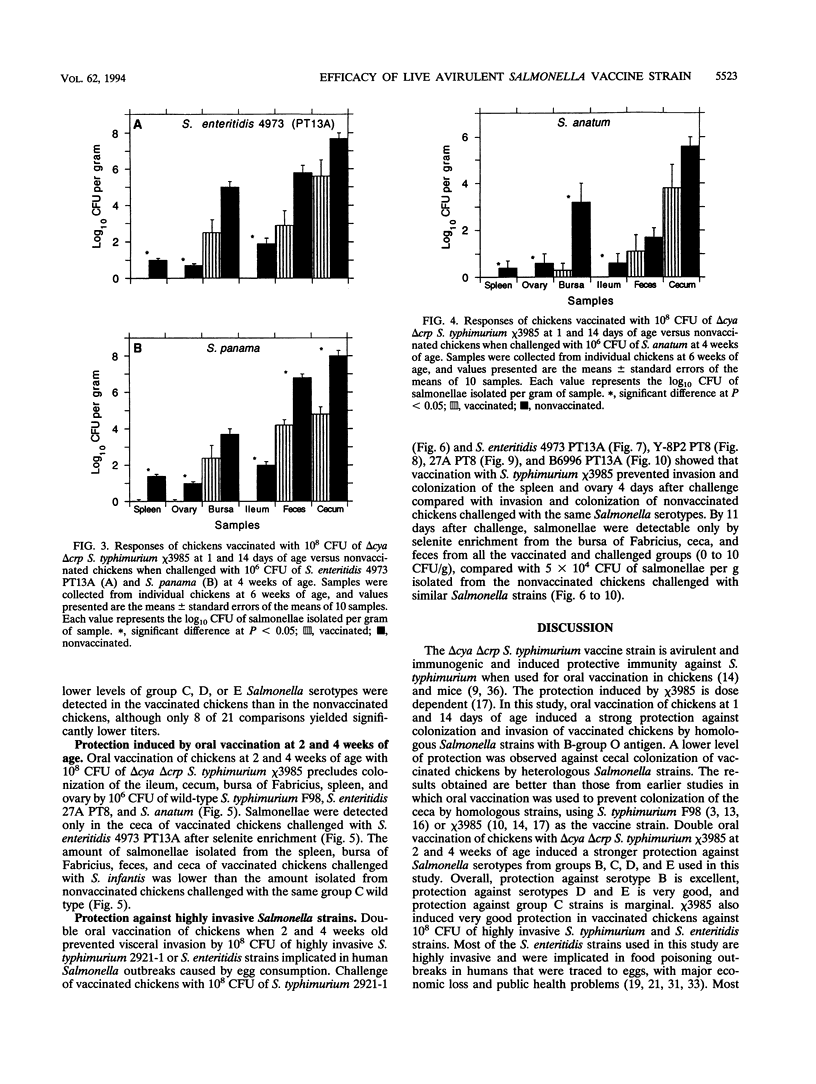
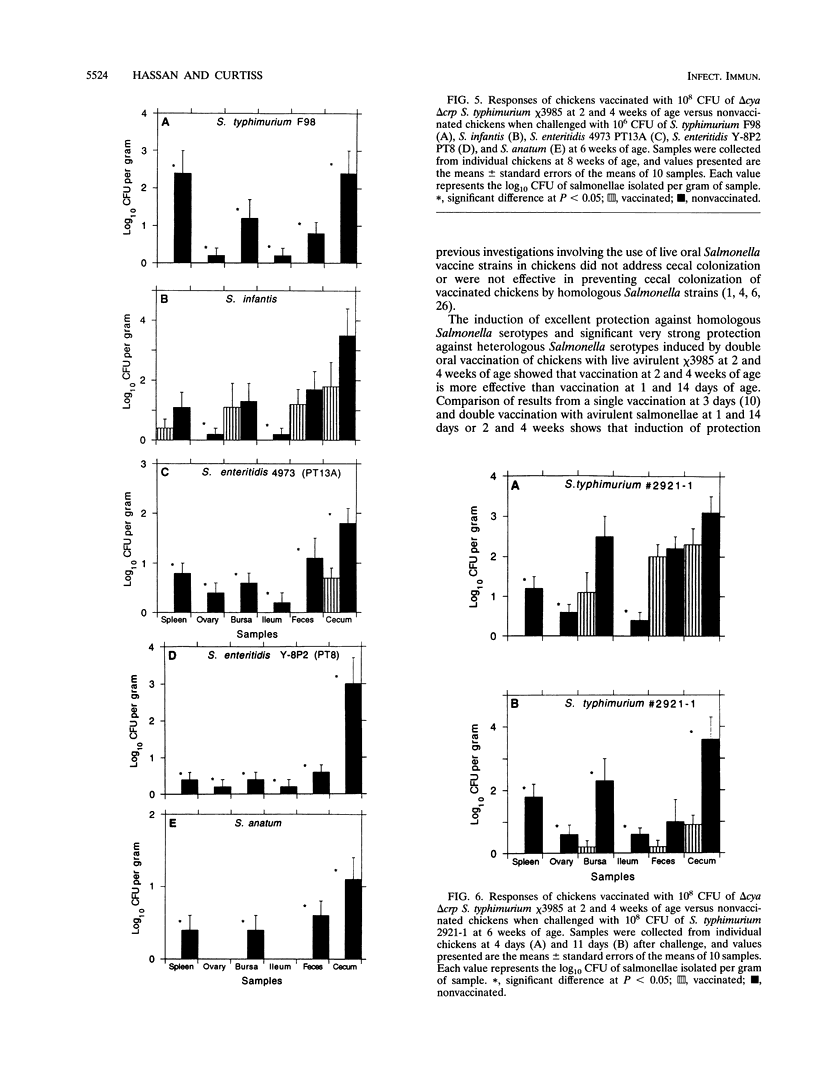
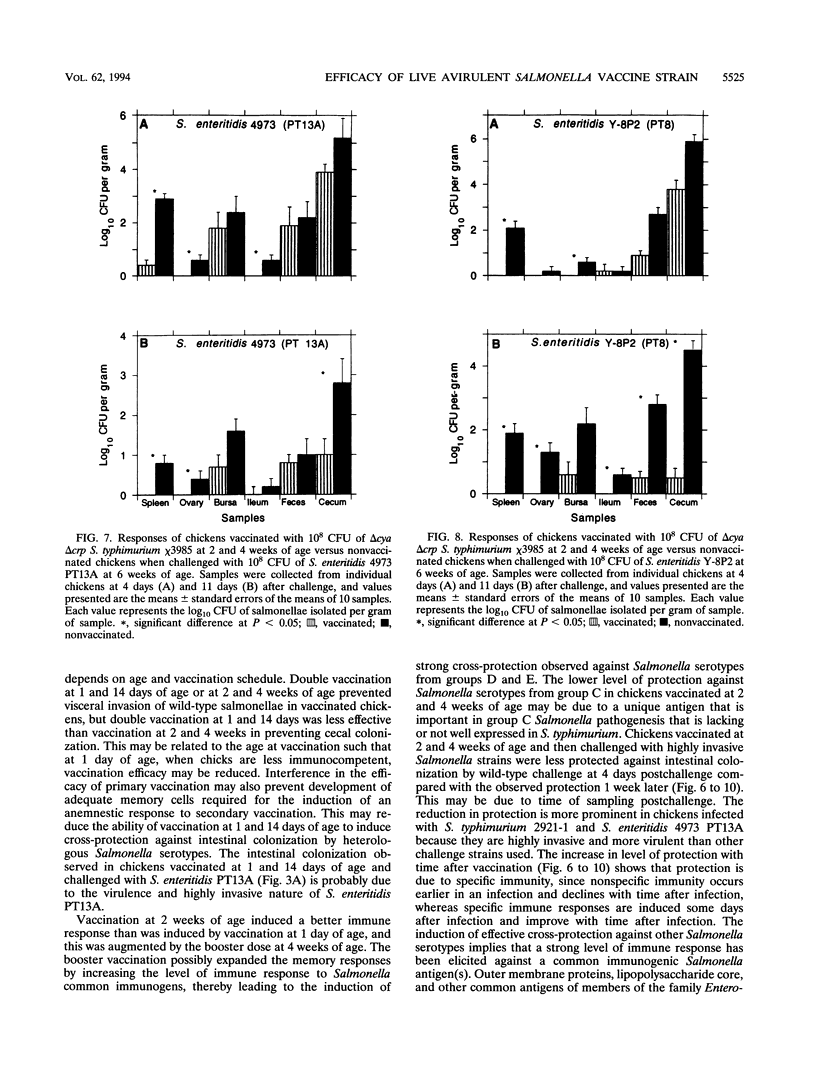
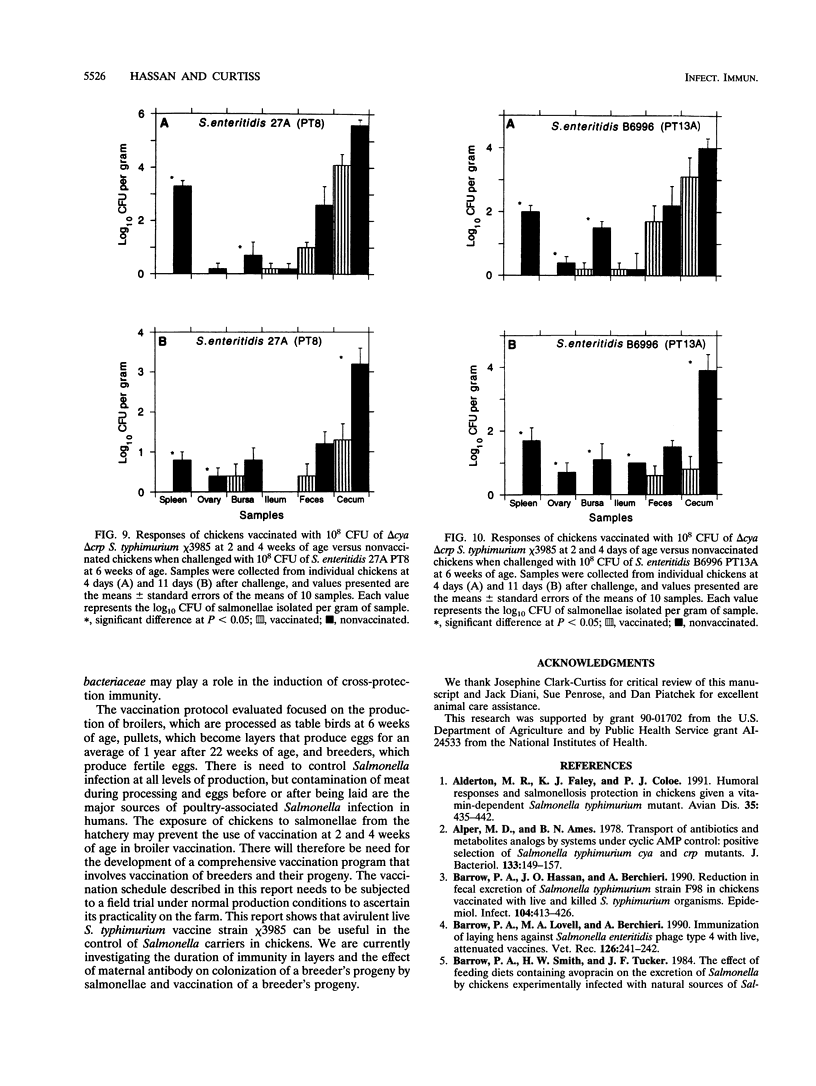
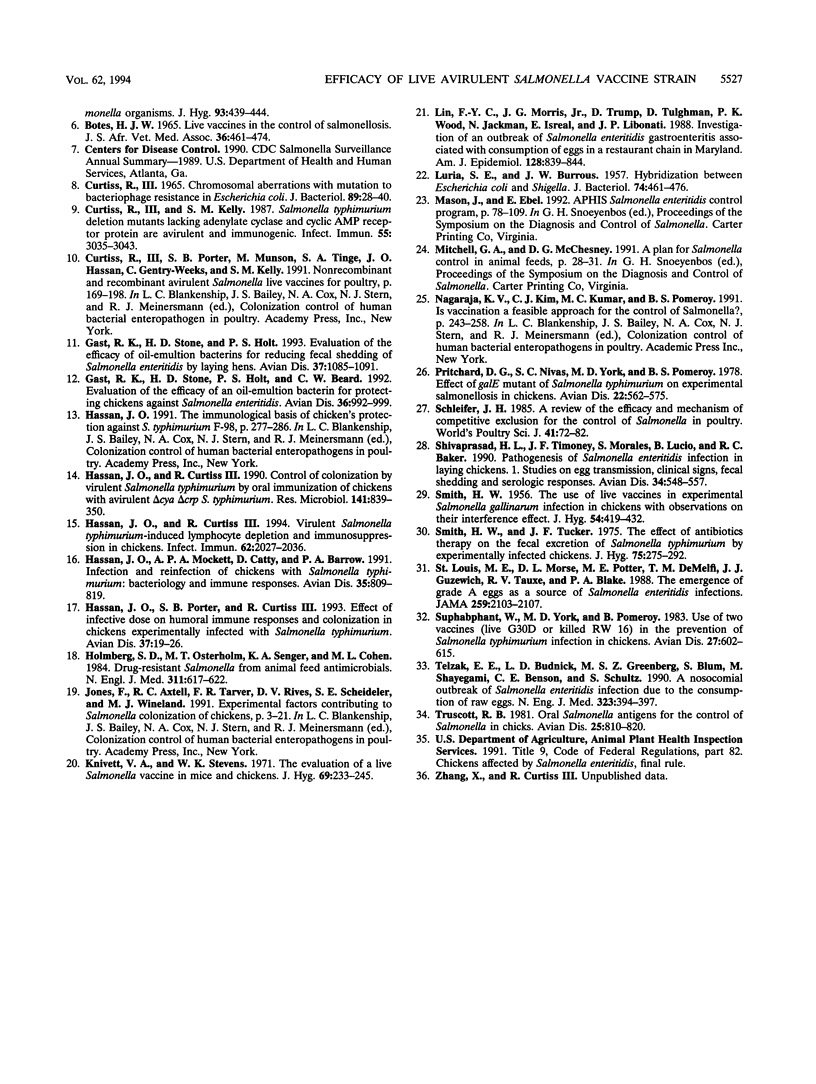
Selected References
These references are in PubMed. This may not be the complete list of references from this article.
- Alderton M. R., Fahey K. J., Coloe P. J. Humoral responses and salmonellosis protection in chickens given a vitamin-dependent Salmonella typhimurium mutant. Avian Dis. 1991 Jul-Sep;35(3):435–442. [PubMed] [Google Scholar]
- Alper M. D., Ames B. N. Transport of antibiotics and metabolite analogs by systems under cyclic AMP control: positive selection of Salmonella typhimurium cya and crp mutants. J Bacteriol. 1978 Jan;133(1):149–157. doi: 10.1128/jb.133.1.149-157.1978. [DOI] [PMC free article] [PubMed] [Google Scholar]
- Barrow P. A., Hassan J. O., Berchieri A., Jr Reduction in faecal excretion of Salmonella typhimurium strain F98 in chickens vaccinated with live and killed S. typhimurium organisms. Epidemiol Infect. 1990 Jun;104(3):413–426. doi: 10.1017/s0950268800047439. [DOI] [PMC free article] [PubMed] [Google Scholar]
- Barrow P. A., Lovell M. A., Berchieri A. Immunisation of laying hens against Salmonella enteritidis with live attenuated vaccines. Vet Rec. 1990 Mar 10;126(10):241–242. [PubMed] [Google Scholar]
- Barrow P. A., Smith H. W., Tucker J. F. The effect of feeding diets containing avoparcin on the excretion of salmonellas by chickens experimentally infected with natural sources of salmonella organisms. J Hyg (Lond) 1984 Dec;93(3):439–444. doi: 10.1017/s0022172400065037. [DOI] [PMC free article] [PubMed] [Google Scholar]
- CURTIS S. R., 3rd CHROMOSOMAL ABERRATIONS ASSOCIATED WITH MUTATIONS TO BACTERIOPHAGE RESISTANCE IN ESCHERICHIA COLI. J Bacteriol. 1965 Jan;89:28–40. doi: 10.1128/jb.89.1.28-40.1965. [DOI] [PMC free article] [PubMed] [Google Scholar]
- Curtiss R., 3rd, Kelly S. M. Salmonella typhimurium deletion mutants lacking adenylate cyclase and cyclic AMP receptor protein are avirulent and immunogenic. Infect Immun. 1987 Dec;55(12):3035–3043. doi: 10.1128/iai.55.12.3035-3043.1987. [DOI] [PMC free article] [PubMed] [Google Scholar]
- Gast R. K., Stone H. D., Holt P. S., Beard C. W. Evaluation of the efficacy of an oil-emulsion bacterin for protecting chickens against Salmonella enteritidis. Avian Dis. 1992 Oct-Dec;36(4):992–999. [PubMed] [Google Scholar]
- Gast R. K., Stone H. D., Holt P. S. Evaluation of the efficacy of oil-emulsion bacterins for reducing fecal shedding of Salmonella enteritidis by laying hens. Avian Dis. 1993 Oct-Dec;37(4):1085–1091. [PubMed] [Google Scholar]
- Hassan J. O., Curtiss R., 3rd Control of colonization by virulent Salmonella typhimurium by oral immunization of chickens with avirulent delta cya delta crp S. typhimurium. Res Microbiol. 1990 Sep-Oct;141(7-8):839–850. doi: 10.1016/0923-2508(90)90119-b. [DOI] [PubMed] [Google Scholar]
- Hassan J. O., Curtiss R., 3rd Virulent Salmonella typhimurium-induced lymphocyte depletion and immunosuppression in chickens. Infect Immun. 1994 May;62(5):2027–2036. doi: 10.1128/iai.62.5.2027-2036.1994. [DOI] [PMC free article] [PubMed] [Google Scholar]
- Hassan J. O., Mockett A. P., Catty D., Barrow P. A. Infection and reinfection of chickens with Salmonella typhimurium: bacteriology and immune responses. Avian Dis. 1991 Oct-Dec;35(4):809–819. [PubMed] [Google Scholar]
- Hassan J. O., Porter S. B., Curtiss R., 3rd Effect of infective dose on humoral immune responses and colonization in chickens experimentally infected with Salmonella typhimurium. Avian Dis. 1993 Jan-Mar;37(1):19–26. [PubMed] [Google Scholar]
- Holmberg S. D., Osterholm M. T., Senger K. A., Cohen M. L. Drug-resistant Salmonella from animals fed antimicrobials. N Engl J Med. 1984 Sep 6;311(10):617–622. doi: 10.1056/NEJM198409063111001. [DOI] [PubMed] [Google Scholar]
- Knivett V. A., Stevens W. K. The evaluation of a live salmonella vaccine in mice and chickens. J Hyg (Lond) 1971 Jun;69(2):233–245. doi: 10.1017/s002217240002146x. [DOI] [PMC free article] [PubMed] [Google Scholar]
- LURIA S. E., BURROUS J. W. Hybridization between Escherichia coli and Shigella. J Bacteriol. 1957 Oct;74(4):461–476. doi: 10.1128/jb.74.4.461-476.1957. [DOI] [PMC free article] [PubMed] [Google Scholar]
- Lin F. Y., Morris J. G., Jr, Trump D., Tilghman D., Wood P. K., Jackman N., Israel E., Libonati J. P. Investigation of an outbreak of Salmonella enteritidis gastroenteritis associated with consumption of eggs in a restaurant chain in Maryland. Am J Epidemiol. 1988 Oct;128(4):839–844. doi: 10.1093/oxfordjournals.aje.a115037. [DOI] [PubMed] [Google Scholar]
- Pritchard D. G., Nivas S. C., York M. D., Pomeroy B. S. Effects of Gal-E-mutant of Salmonella typhimurium on experimental salmonellosis in chickens. Avian Dis. 1978 Oct-Dec;22(4):562–575. [PubMed] [Google Scholar]
- SMITH H. W. The use of live vaccines in experimental Salmonella gallinarum infection in chickens with observations on their interference effect. J Hyg (Lond) 1956 Sep;54(3):419–432. doi: 10.1017/s0022172400044685. [DOI] [PMC free article] [PubMed] [Google Scholar]
- Shivaprasad H. L., Timoney J. F., Morales S., Lucio B., Baker R. C. Pathogenesis of Salmonella enteritidis infection in laying chickens. I. Studies on egg transmission, clinical signs, fecal shedding, and serologic responses. Avian Dis. 1990 Jul-Sep;34(3):548–557. [PubMed] [Google Scholar]
- Smith H. W., Tucker J. F. The effect of antibiotic therapy on the faecal excretion of Salmonella typhimurium by experimentally infected chickens. J Hyg (Lond) 1975 Oct;75(2):275–292. doi: 10.1017/s0022172400047306. [DOI] [PMC free article] [PubMed] [Google Scholar]
- St Louis M. E., Morse D. L., Potter M. E., DeMelfi T. M., Guzewich J. J., Tauxe R. V., Blake P. A. The emergence of grade A eggs as a major source of Salmonella enteritidis infections. New implications for the control of salmonellosis. JAMA. 1988 Apr 8;259(14):2103–2107. [PubMed] [Google Scholar]
- Suphabphant W., York M. D., Pomeroy B. S. Use of two vaccines (live G30D or killed RW16) in the prevention of Salmonella typhimurium infections in chickens. Avian Dis. 1983 Jul-Sep;27(3):602–615. [PubMed] [Google Scholar]
- Telzak E. E., Budnick L. D., Greenberg M. S., Blum S., Shayegani M., Benson C. E., Schultz S. A nosocomial outbreak of Salmonella enteritidis infection due to the consumption of raw eggs. N Engl J Med. 1990 Aug 9;323(6):394–397. doi: 10.1056/NEJM199008093230607. [DOI] [PubMed] [Google Scholar]
- Truscott R. B. Oral salmonella antigens for the control of salmonella in chickens. Avian Dis. 1981 Oct-Dec;25(4):810–820. [PubMed] [Google Scholar]


